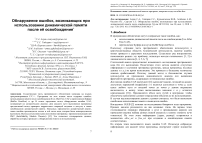Обнаружение ошибок, возникающих при использовании динамической памяти после её освобождения
Автор: Асрян С.А., Гайсарян С.С., Курмангалеев Ш.Ф., Агабалян А.М., Овсепян Н.Г., Саргсян С.С.
Журнал: Труды Института системного программирования РАН @trudy-isp-ran
Статья в выпуске: 3 т.30, 2018 года.
Бесплатный доступ
Существенная часть программного обеспечения написана на языках программирования C/C++. Программы на этих языках часто содержат ошибки: использования памяти после освобождения (Use After Free, UAF), переполнения буфера (Buffer Overflow) и др. В статье предложен метод обнаружения ошибок UAF, основанный на динамическом анализе. Для каждого пути выполнения программы предлагаемый метод проверяет корректность операций создания и доступа, а также освобождения динамической памяти. Поскольку применяется динамический анализ, поиск ошибок производится только в той части кода, которая была непосредственно выполнена. Используется символьное исполнение программы с применением решателей SMT (Satisfiability Modulo Theories) [12]. Это позволяет сгенерировать данные, обработка которых приводит к обнаружению нового пути выполнения.
Динамический анализ программ, покрытие кода
Короткий адрес: https://sciup.org/14916552
IDR: 14916552 | DOI: 10.15514/ISPRAS-2018-30(3)-1
Список литературы Обнаружение ошибок, возникающих при использовании динамической памяти после её освобождения
- D. Dewey, B. Reaves, P. Trainor. Uncovering Use-After-Free Conditions in Compiled Code. In Proc of the 10th International Conference on Availability, Reliability and Security (ARES), 2015, pp. 90-99
- J. Feist, L. Mounier, ML. Potet. Statically detecting use after free on binary code. Journal of Computer Virology and Hacking Techniques, vol. 10, issue 3, 2014, pp 211-217
- Ildar Isaev, Denis Sidorov, Alexander Gerasimov, Mikhail Ermakov. Avalanche: Using dynamic analysis for automatic defect detection in programs based on network sockets. Trudy ISP RAN/Proc. ISP RAS, vol. 21, 2011, pp. 55-70.
- B. Lee, Ch. Song, Y. Jang, T. Wang. Preventing Use-after-free with Dangling Pointers Nullification. In Proc of the Network and Distributed System Security Symposium, 2015, https://www.ndss-symposium.org/ndss2015/ndss-2015-programme/preventing-use-after-free-dangling-pointers-nullification/, accessed at 05.05.2018
- Yves Younan. FreeSentry: Protecting Against Use-After-Free Vulnerabilities Due to Dangling Pointers. In Proc of the Network and Distributed System Security Symposium, 2015, https://www.ndss-symposium.org/ndss2015/ndss-2015-programme/freesentry-protecting-against-use-after-free-vulnerabilities-due-dangling-pointers/, accessed at 05.05.2018
- J. Caballero, G. Grieco, M. Marron, A. Nappa. Undangle: Early Detection of Dangling Pointers in Use-After-Free and Double-Free Vulnerabilities. In Proceedings of the 2012 International Symposium on Software Testing and Analysis, 2012, pp. 133-143
- Sang Kil Cha, Thanassis Avgerinos, Alexandre Rebert and David Brumley. Unleashing MAYHEM on Binary Code. In Proceedings of the 2012 IEEE Symposium on Security and Privacy, 2012, pp. 380-394
- Pin -A Dynamic Binary Instrumentation Tool, https://software.intel.com/en-us/articles/pin-a-dynamic-binary-instrumentation-tool, accessed at 05.05.2018
- Triton -Dynamic Binary Analysis Framework, https://triton.quarkslab.com/, accessed at 05.05.2018
- P. Godefroid, M. Y. Levin, D. Molnar. Automated Whitebox Fuzz Testing. In Proceedings of NDSS'2008 (Network and Distributed Systems Security), 2008, pp. 151-166.
- A. Aho, J. Ullman, R. Sethi, M. S. Lam. Compilers: Principles, Techniques, and Tools. Addison Wesley; 2nd edition, September 10, 2006, 1000 p.
- Leonardo de Moura, Nikolaj Bjørner. Z3: an efficient SMT solver. In Proceedings of the 14th international conference on Tools and algorithms for the construction and analysis of systems, 2008, pp. 337-340


